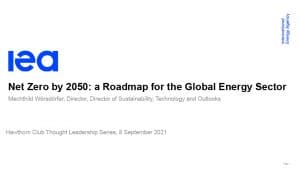WEDNESDAY SEPTEMBER 08, 2021
Mechthild Wörsdörfer
IEA
Alison Reeve
Grattan Institute
Net Zero by ‘2050’
The International Energy Agency (IEA) has once again produced some of the most comprehensive analysis of transitioning to a net zero energy global economy, to feed into the discussions at the upcoming COP26 in Glasgow, November 2021. Hawthorn Club Members were fortunate to have Mechthild Wörsdörfer, Director of Sustainability, Technology and Outlooks at the IEA, talk us through key aspects of the IEA’s Net Zero by 2050 analysis. Three key sobering messages based on the analysis include:
- If countries around the world implement only their current stated policy scenarios, then oil demand will increase slightly by 2050!
- Annual clean energy investment will need to more than triple by 2030 to achieve net zero emissions by 2050. This investment has an opportunity to drive an average of 0.4% per year increase in global GDP to 2030 and speed the recovery from the COVID-19 shock.
- On a net zero trajectory, by 2030 there will be an estimated 14 million jobs created in global energy supply, and a further 16 million in clean energy end-uses. 65% of these will be highly skilled. Of course, inclusive policies are needed to support reskilling & diversification in fossil-fuel dependent communities.
The pathway laid out in the IEA’s report is from a global perspective. Mechthild reminded us that each country’s trajectory will need to follow their own strategy and be designed around its specific circumstances. To bring the global perspective back to a country-specific perspective, Alison Reeve, Climate Change and Energy Deputy Program Director at Grattan Institute, gave an overview of key considerations for how Australia can meet a net zero by 2050 goal. Three take-away messages from her presentation include:
- Australia’s emission profile is very dependent on the global demand for fossil fuel, given the significant emissions associated with producing coal, oil and gas.
- A net-zero pathway presents a huge economic growth opportunity for Australia; while it would require a move away from fossil fuels export revenue, critical minerals export revenue would expand.
- While 2050 might be ten election cycles away for the Federal Government, industry and even consumer decisions made now (or in the next few years) can lock-in an emissions profile until 2050. This is based on the longevity of industrial facilities and products like cars.




